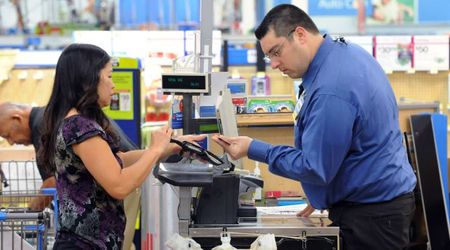Retail Giants Implement Changes to Combat Theft at Self-Checkout

To tackle rising concerns over theft at self-checkout stations major retailers like Walmart and Target are rolling out strategic changes, albeit with potential repercussions for customers. These adjustments come amidst growing apprehension regarding the effectiveness and security of self-checkout systems. The move reflects an ongoing battle faced by retailers to maintain the integrity of their checkout processes while balancing customer convenience and security.

Heightened Security Measures at Self-Checkout
Target has initiated a policy to limit the number of items customers can scan at self-checkout registers in certain stores. Additionally, the company has introduced express self-checkout lanes designated for customers with ten items or fewer at nearly 2,000 stores nationwide.
Walmart, on the other hand, is experimenting with various strategies, including limiting the number of items allowed for scanning at self-checkout stations and adjusting operational hours for these facilities. It has also designated specific self-checkout stations exclusively for Walmart+ members and delivery drivers utilizing the Spark app.

This move aims to streamline the checkout process for these individuals, offering them expedited service and additional perks.
Implications for Non-Members
While these changes may enhance the checkout experience for Walmart+ members and Spark delivery drivers, non-members could face potential inconvenience and longer wait times. The selective allocation of self-checkout stations may restrict access for regular customers, prompting concerns over equitable treatment and customer satisfaction.
"There is the potential for non-Walmart+ customers to become agitated, they are losing convenience because they are not enrolled. Customers looking for convenience will have fewer options for speed to check out," said Andy Keenan, Executive Vice President at Advantage Solutions.
Industry Outlook
According to Keenan, while self-checkout presents certain challenges, it remains a pivotal component of the evolving retail landscape. "Self-checkouts are actually part of the next evolution of the retail customer experience, and evolutions take time," he said.

Despite occasional setbacks and concerns over theft, he asserts that self-checkout is here to stay, serving as an essential tool for retailers to streamline operations and enhance the customer experience.
"The noise that, 'Oh, self-checkout might not be working,' that’s just a moment in time," he added.
Customer Feedback and Response
The changes implemented by Walmart and Target have garnered mixed reactions from customers, with some expressing frustration over potential restrictions and inconvenience.
While speculation persists regarding the motives behind these changes, retailers emphasize the necessity of adapting to fluctuating customer flow and operational demands. Brian K. Little, Global Communications Director at Walmart Corporate Affairs, clarifies that these adjustments are part of routine operational procedures aimed at optimizing checkout availability.

Despite these changes, retailers like Target remain committed to offering options to cater to varying customer preferences. Alongside self-checkout facilities, Target continues to prioritize human cashiers and invest in additional training to ensure exceptional customer service. Furthermore, Target customers can leverage alternative services such as drive-up and same-day delivery to streamline their shopping experience.





















